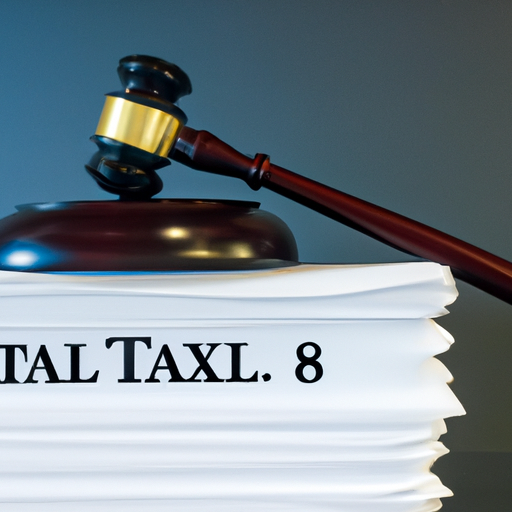Looking to maximize your business savings? Tax deductions could be the key to reducing your tax liabilities and keeping more money in your pocket. In this article, we will explore the various tax deductions that can benefit your business and help you save significantly. From business expenses to employee benefits, we’ll provide you with valuable insights and tips on how to navigate the complex world of tax deductions. So, whether you’re a small business owner or the head of a large corporation, read on to discover how you can optimize your tax situation and ultimately increase your business savings. And don’t forget to check out the FAQs at the end of this article for even more useful information!

Understanding Tax Deductions
Tax deductions are expenses that can be deducted from your taxable income, reducing the amount of tax you owe. These deductions are important for businesses because they help lower the overall tax burden and increase savings. By taking advantage of tax deductions, businesses can maximize their savings and allocate those funds towards other areas of the business.
Different types of tax deductions
There are several types of tax deductions that businesses can utilize to reduce their taxable income. Some common types of tax deductions include:
-
Business expenses: These are ordinary and necessary expenses incurred in the course of running a business, such as office rent, utilities, office supplies, and employee salaries.
-
Business travel: Expenses related to business travel, including airfare, hotel accommodations, meals, and transportation, can be deducted.
-
Home office deductions: If you have a dedicated space in your home that is used exclusively for your business, you may be able to deduct a portion of your home expenses, such as rent or mortgage interest, utilities, and insurance.
-
Depreciation: Businesses can deduct the cost of assets used in their business over time through depreciation. This includes items like office equipment, vehicles, and machinery.
-
Health insurance premiums: Small business owners may be eligible to deduct the cost of health insurance premiums for themselves and their employees.
-
Retirement contributions: Contributions made to retirement plans, such as a 401(k) or SEP IRA, can be deducted from taxable income.
-
Business losses: If your business operates at a loss, you may be able to deduct those losses from your taxable income.
Understanding and utilizing these different types of tax deductions can help businesses maximize their savings and minimize their tax liability.
Identifying Deductible Business Expenses
To take advantage of tax deductions, businesses must first identify which expenses are deductible. Some common deductible business expenses include:
-
Office rent: The cost of renting office space is typically fully deductible.
-
Office supplies: Expenses for office supplies like paper, pens, and printer ink are deductible.
-
Employee wages: Wages paid to employees are deductible business expenses.
-
Business utilities: Expenses for utilities like electricity, water, and internet services can be deducted.
-
Advertising and marketing expenses: Costs associated with advertising and promoting your business are deductible.
-
Professional services: Fees paid to lawyers, accountants, and consultants are often deductible.
-
Travel expenses: Expenses incurred during business travel, such as airfare, hotel accommodations, and meals, are deductible.
It is important to keep detailed records of all deductible expenses in case of an audit by the Internal Revenue Service (IRS). Proper record keeping will help ensure that you have the necessary documentation to support your deduction claims.
Maximizing Deductions for Business Travel
Business travel can be a significant expense for businesses, but it also offers opportunities for tax deductions. To maximize deductions for business travel, you need to understand what qualifies as business travel and what expenses can be deducted.
What qualifies as business travel?
Business travel refers to trips taken away from your tax home for business purposes. To qualify for deductions, the travel must be necessary and primarily for business purposes. This could include attending conferences, meeting with clients or suppliers, or visiting a business location.
Deductible expenses for business travel
When it comes to deducting expenses for business travel, there are several categories that you can consider:
-
Transportation: This includes airfare, train tickets, and rental car expenses.
-
Accommodations: The cost of hotel accommodations during your business trip is deductible.
-
Meals: You can deduct the cost of meals incurred during business travel, but only up to a certain limit set by the IRS.
-
Business-related expenses: Expenses such as internet fees, conference registration fees, and tips for bellhops or housekeeping staff can also be deducted.
It is important to keep detailed records of all expenses related to business travel, including receipts and documentation that support the business purpose of the trip.
Tips for maximizing business travel deductions
To maximize your deductions for business travel, consider the following tips:
-
Plan your trips strategically: By combining multiple business activities into one trip, you can increase the number of deductible expenses.
-
Keep accurate records: Maintain a travel log that includes details of each trip, including the purpose of the trip, dates, locations, and expenses incurred.
-
Separate personal and business expenses: Ensure that you only deduct expenses that are directly related to your business activities. Avoid deducting personal expenses or activities that are unrelated to your business.
Maximizing your deductions for business travel requires careful planning and documentation, but it can significantly reduce your taxable income and save your business money.
Taking Advantage of Home Office Deductions
As more businesses operate remotely, home office deductions have become increasingly relevant. To take advantage of home office deductions, you must meet certain requirements and understand the different calculation methods available.
Requirements for home office deductions
To qualify for home office deductions, you must meet the following requirements:
-
Exclusive and regular use: The space in your home that you use as a home office must be used exclusively for business purposes. It should also be regularly used for your business.
-
Principal place of business: Your home office must be your primary place of business. This means that you conduct a substantial amount of your business activities from your home office.
Calculation methods for home office deductions
There are two methods for calculating home office deductions:
-
Simplified option: With the simplified option, you can deduct a standard rate per square foot of your home office space. This rate is set by the IRS each year.
-
Regular method: The regular method involves calculating the actual expenses associated with your home office, such as rent or mortgage interest, utilities, and maintenance costs. These expenses are then prorated based on the percentage of your home used for business.
Tips for maximizing home office deductions
To maximize your home office deductions, keep the following tips in mind:
-
Maintain a dedicated workspace: Ensure that you have a designated area in your home that is used exclusively for your business. This helps establish the exclusive use required for deductions.
-
Keep detailed records: Track all expenses related to your home office, including rent or mortgage payments, utilities, and maintenance costs. Keep receipts and invoices as supporting documentation.
-
Consult with a tax professional: Home office deductions can be complex, so it is beneficial to seek advice from a tax professional who can guide you through the process and help you maximize your deductions.
Taking advantage of home office deductions can provide significant tax savings for businesses that operate from a home office. By understanding the requirements and calculation methods, businesses can lower their taxable income and increase their overall savings.
Understanding Depreciation and Asset Deductions
Depreciation allows businesses to deduct the cost of assets over time, reflecting the gradual consumption or obsolescence of those assets. There are different methods and rules related to depreciation, including bonus depreciation and the Section 179 deduction.
Depreciation of business assets
Businesses can depreciate the cost of tangible assets used in their business over the asset’s useful life. This includes items such as office furniture, vehicles, machinery, and equipment. By deducting the cost of these assets over time, businesses can spread out the expense and reduce their taxable income.
Bonus depreciation
Bonus depreciation is a tax incentive that allows businesses to deduct a percentage of the cost of qualifying assets in the year they are placed in service. This can provide significant tax savings, especially for businesses that invest heavily in new equipment or technology.
Section 179 deduction
The Section 179 deduction allows businesses to deduct the full cost of qualifying assets in the year they are placed in service, rather than depreciating them over time. This deduction is subject to certain limitations, such as a maximum deduction limit and a taxable income limitation.
Understanding the rules and options related to depreciation and asset deductions can help businesses maximize their tax savings and allocate resources towards other business priorities.

Small Business Health Insurance Deductions
Eligible small businesses can take advantage of deductions related to health insurance premiums paid for themselves and their employees. These deductions can help reduce the overall cost of providing health insurance benefits.
Eligibility for health insurance deductions
To be eligible for health insurance deductions, a small business must meet certain criteria. Generally, these deductions are available to businesses that provide health insurance coverage to their employees and meet specific size requirements.
Deductible health insurance premiums
The premiums paid by a small business for health insurance coverage for its employees can be deducted as a business expense. This deduction helps reduce the overall cost of providing health insurance benefits and encourages small businesses to offer these benefits to their employees.
Health Savings Accounts (HSAs)
Health Savings Accounts (HSAs) are another way for small businesses to maximize savings related to health insurance. HSAs are tax-advantaged savings accounts that can be used to pay for qualified medical expenses. Contributions made to HSAs are tax-deductible, and withdrawals used for qualified medical expenses are tax-free.
By utilizing health insurance deductions and HSAs, small businesses can provide valuable health insurance benefits to their employees while minimizing the financial impact on their bottom line.
Retirement Contributions and Tax Savings
One of the ways business owners can reduce their taxable income and save for retirement is by contributing to retirement plans. There are several retirement plan options available for business owners, each with its own tax benefits.
Retirement plan options for business owners
Business owners have a variety of retirement plan options to choose from, depending on their business structure and their goals for retirement savings. Some common retirement plan options for business owners include:
-
Simplified Employee Pension (SEP) IRA: This plan allows business owners to make tax-deductible contributions on behalf of themselves and their employees.
-
Savings Incentive Match Plan for Employees (SIMPLE) IRA: This plan is designed for small businesses with fewer than 100 employees and allows for tax-deductible contributions.
-
401(k) plans: These plans offer higher contribution limits and more flexibility in investment options. Business owners can make contributions for themselves as well as their employees.
Tax benefits of contributing to retirement plans
Contributing to retirement plans offers several tax benefits for business owners, including:
-
Tax-deductible contributions: Contributions made to retirement plans are generally tax-deductible, reducing taxable income.
-
Tax-deferred growth: The funds in a retirement plan grow tax-deferred until they are withdrawn, allowing for potentially higher investment returns.
-
Employer match: Many retirement plans allow business owners to provide matching contributions for their employees. These employer match contributions are also tax-deductible.
Maximizing contributions and tax savings
To maximize contributions and tax savings, business owners should consider the following strategies:
-
Determine the right retirement plan for your business: Consult with a financial advisor or retirement plan specialist to determine the best retirement plan option for your business needs.
-
Take advantage of catch-up contributions: Business owners who are 50 or older can make additional catch-up contributions to their retirement plans, allowing for higher savings potential.
-
Review contribution limits annually: Contribution limits for retirement plans may change each year, so be sure to review and adjust your contributions accordingly.
By contributing to retirement plans and taking advantage of the tax benefits associated with them, business owners can save for retirement while reducing their taxable income.

Taking Advantage of Business Loss Deductions
Businesses may experience periods when they operate at a loss, which can impact their taxable income. Understanding business loss deductions and how they can be used to offset income is essential for maximizing tax savings.
Understanding business loss deductions
Business loss deductions allow businesses to deduct losses incurred during a given tax year from their taxable income. This can help offset income from other sources and reduce the overall tax liability.
Offsetting income with business losses
Business losses can be used to offset income from other sources, such as wages, investment income, or income from other businesses. This can help reduce the overall tax liability and potentially result in a tax refund.
Carrying forward business losses
If business losses exceed the amount of income earned in a particular tax year, the excess losses can be carried forward to future tax years. These losses can be used to offset income in future years and further reduce the tax liability.
Understanding the rules and options related to business loss deductions is crucial for businesses that may experience periods of financial difficulty. By utilizing these deductions, businesses can minimize the impact of losses and improve their overall financial health.
Deducting Business Interest Expenses
Businesses commonly take out loans or lines of credit to support their operations or finance expansion. Deducting business interest expenses can help reduce the overall cost of borrowing and provide tax savings.
What qualifies as business interest?
Business interest refers to the interest paid or accrued on business loans or lines of credit. This includes interest paid on mortgages, vehicle loans, and other borrowing used for business purposes.
Limits on deducting business interest expenses
The deduction for business interest expenses is subject to certain limitations. The Tax Cuts and Jobs Act (TCJA) introduced changes to the rules surrounding business interest deductions. Under the TCJA, the deduction for business interest expenses is generally limited to 30% of adjusted taxable income.
Optimizing business interest deductions
To optimize business interest deductions, businesses can consider the following strategies:
-
Structure loans properly: By structuring loans as business debt rather than personal debt, businesses can ensure that the interest paid on those loans is fully deductible.
-
Consider alternative financing options: If the 30% limit on business interest deductions poses a challenge, businesses can explore alternative financing options, such as equity financing or leasing, which may have different tax implications.
-
Consult with a tax professional: Business interest deductions can be complex, especially with the changes introduced by the TCJA. Working with a tax professional can help ensure that you maximize your deductions within the limits of the law.
By deducting business interest expenses, businesses can reduce their tax liability and free up additional funds to reinvest in their operations or allocate towards other business needs.
Frequently Asked Questions
What is the difference between a tax deduction and a tax credit?
A tax deduction reduces your taxable income, while a tax credit directly reduces the amount of tax you owe. Deductions lower your overall taxable income, which in turn lowers the amount of tax you owe. On the other hand, tax credits are applied directly to your tax liability, reducing the amount of tax you owe dollar-for-dollar. Both deductions and credits can help lower your tax bill, but they work in different ways.
Can I amend my tax return to claim missed deductions?
Yes, you can amend your tax return to claim missed deductions. If you realize that you have missed out on claiming certain deductions, you can file an amended tax return using Form 1040X. This allows you to correct any errors or omissions in your original return and claim any deductions that you may have missed.
Are there any tax deductions specifically for self-employed individuals?
Yes, there are several tax deductions that are specifically available to self-employed individuals. These include deductions for business expenses, home office expenses, health insurance premiums, retirement plan contributions, and more. It is important for self-employed individuals to understand the specific deductions they may be eligible for and to keep detailed records of their business expenses to support their deductions.

















































